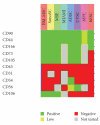Proteomic definitions of mesenchymal stem cells
- PMID: 21437194
- PMCID: PMC3062154
- DOI: 10.4061/2011/704256
Proteomic definitions of mesenchymal stem cells
Abstract
Mesenchymal stem cells (MSCs) are pluripotent cells isolated from the bone marrow and various other organs. They are able to proliferate and self-renew, as well as to give rise to progeny of at least the osteogenic, chondrogenic, and adipogenic lineages. Despite this functional definition, MSCs can also be defined by their expression of a distinct set of cell surface markers. In the current paper, studies investigating the proteome of human MSCs are reviewed with the aim to identify common protein markers of MSCs. The proteomic analysis of MSCs revealed a distinct set of proteins representing the basic molecular inventory, including proteins for (i) cell surface markers, (ii) the responsiveness to growth factors, (iii) the reuse of developmental signaling cascades in adult stem cells, (iv) the interaction with molecules of the extracellular matrix, (v) the expression of genes regulating transcription and translation, (vi) the control of the cell number, and (vii) the protection against cellular stress.
Figures




Similar articles
-
Mapping of equine mesenchymal stromal cell surface proteomes for identification of specific markers using proteomics and gene expression analysis: an in vitro cross-sectional study.Stem Cell Res Ther. 2018 Oct 25;9(1):288. doi: 10.1186/s13287-018-1041-8. Stem Cell Res Ther. 2018. PMID: 30359315 Free PMC article.
-
Induced Pluripotent Stem Cell-Derived Mesenchymal Stromal Cells Are Functionally and Genetically Different From Bone Marrow-Derived Mesenchymal Stromal Cells.Stem Cells. 2019 Jun;37(6):754-765. doi: 10.1002/stem.2993. Epub 2019 Mar 6. Stem Cells. 2019. PMID: 30779868 Free PMC article.
-
Bone marrow mesenchymal stromal cells isolated from multiple sclerosis patients have distinct gene expression profile and decreased suppressive function compared with healthy counterparts.Cell Transplant. 2015;24(2):151-65. doi: 10.3727/096368913X675142. Epub 2013 Nov 20. Cell Transplant. 2015. PMID: 24256874
-
Mesenchymal stem cells for cardiac cell therapy.Hum Gene Ther. 2011 Jan;22(1):3-17. doi: 10.1089/hum.2010.211. Hum Gene Ther. 2011. PMID: 21062128 Review.
-
Mesenchymal stem cells: Cell therapy and regeneration potential.J Tissue Eng Regen Med. 2019 Sep;13(9):1738-1755. doi: 10.1002/term.2914. Epub 2019 Jul 25. J Tissue Eng Regen Med. 2019. PMID: 31216380 Review.
Cited by
-
Antimicrobial peptides secreted by equine mesenchymal stromal cells inhibit the growth of bacteria commonly found in skin wounds.Stem Cell Res Ther. 2017 Jul 4;8(1):157. doi: 10.1186/s13287-017-0610-6. Stem Cell Res Ther. 2017. PMID: 28676123 Free PMC article.
-
Human Umbilical Cord Blood-Derived Mesenchymal Stem Cells Contribute to Chondrogenesis in Coculture with Chondrocytes.Biomed Res Int. 2016;2016:3827057. doi: 10.1155/2016/3827057. Epub 2016 Jun 30. Biomed Res Int. 2016. PMID: 27446948 Free PMC article.
-
Characteristics and Potentiality of Human Adipose-Derived Stem Cells (hASCs) Obtained from Enzymatic Digestion of Fat Graft.Cells. 2019 Mar 25;8(3):282. doi: 10.3390/cells8030282. Cells. 2019. PMID: 30934588 Free PMC article.
-
Tissue regeneration and stem cell distribution in adriamycin induced glomerulopathy.Int J Stem Cells. 2012 Nov;5(2):115-24. doi: 10.15283/ijsc.2012.5.2.115. Int J Stem Cells. 2012. PMID: 24298364 Free PMC article.
-
Role of stem/progenitor cells in reparative disorders.Fibrogenesis Tissue Repair. 2012 Dec 27;5(1):20. doi: 10.1186/1755-1536-5-20. Fibrogenesis Tissue Repair. 2012. PMID: 23270300 Free PMC article.
References
-
- National Institutes of Health. Regenerative Medicine. 2006, http://stemcells.nih.gov/staticresources/info/scireport/PDFs/Regenerativ....
-
- Bernardo ME, Locatelli F, Fibbe WE. Mesenchymal stromal cells: a novel treatment modality for tissue repair. Annals of the New York Academy of Sciences. 2009;1176:101–117. - PubMed
-
- Maurer MH, Kuschinsky W. Chapter 7.1: proteomics. In: Lajtha A, Gibson GE, Dienel GA, editors. Handbook of Neurochemistry and Molecular Neurobiology. Vol. 5. New York, NY, USA: Springer; 2007. pp. 737–769. (Brain Energetics. Integration of Cellular and Molecular Processes).
LinkOut - more resources
Full Text Sources

